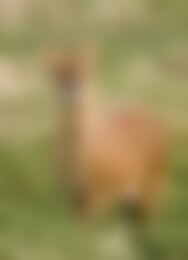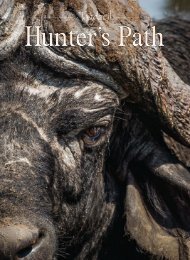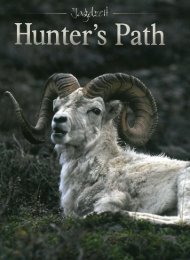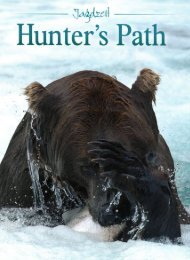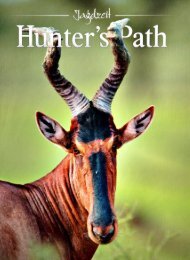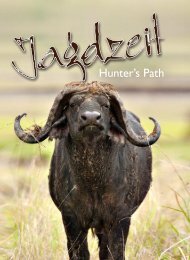Create successful ePaper yourself
Turn your PDF publications into a flip-book with our unique Google optimized e-Paper software.
Wild Eurasian brown bear are a standard occupational hazard if you’re an<br />
indigenous Sámi reindeer herder in Sweden. “This is not Disney, bear are dangerous,”<br />
explained fifth-generation herder Mattias Sparrock via an interpreter<br />
as he welcomed us to the remote, unfenced Jämtland hunting camp, adding: “If<br />
they’re hungry they will kill you and bury you. Then, when they want to eat<br />
you they will dig you up.”<br />
Top: Jämtland is only accessible via a<br />
45-minute helicopter transfer.<br />
Bottom: The pilot explains to Simon<br />
where he would be landing.<br />
Thankfully, bear attacks on humans are<br />
relatively rare in Sweden. There have<br />
been just two fatalities in the past forty<br />
years. Most recently, in 2014, an eightyyear-old<br />
man was attacked by a protective<br />
sow nursing three cubs while he was fishing<br />
by a lake in Homnabo. Despite some serious<br />
bite wounds, he lived to tell the tale. A<br />
protected species, bear can only be hunted<br />
with a license. Around 230 permits are<br />
granted each year to help safeguard livestock<br />
and to keep the population healthy.<br />
Hunting apex predators is often controversial<br />
and emotive, so my wife Selena and<br />
I were especially interested to learn more<br />
about the management of this iconic species<br />
in one of its native home ranges.<br />
Typically, there are two ways of hunting<br />
a free-ranging, wild bruin: driven with dogs<br />
or stalking on foot. We opted for the latter.<br />
Organised by Lars Andersson and Markus<br />
Johansson of the renowned Swedish outfitter<br />
Exclusive Adventure, the week-long<br />
expedition required intense physical training<br />
beforehand, as we’d be hiking for twelve<br />
hours each day. The shooting distance<br />
could be anything out to three hundred<br />
metres, so adequate range time was also<br />
a prerequisite. This hunt was the ultimate<br />
test of endurance, fitness and field craft. It<br />
doesn’t get much more ‘fair chase’ than that.<br />
Camp was a simple wooden cabin<br />
with communal bunk beds. There was no<br />
running water, electricity or phone signal.<br />
Lars reassured me however that the thin<br />
walls would prevent us from being eaten in<br />
the night. Accessed via a spectacular forty-five-minute<br />
helicopter flight, the camp<br />
felt incredibly isolated from civilization.<br />
Being completely cut-off from the twenty-first<br />
century felt pleasingly cathartic. In<br />
a world where we are increasingly dictated<br />
to by emails, mobile phones and laptops, it<br />
was great to reignite my primeval senses,<br />
live simply and hunt intensively from dawn<br />
until dusk. This kind of backcountry hunting<br />
should be available on prescription.<br />
Jämtland is in the heart of the Scandinavian<br />
Peninsula and is one of Sweden’s<br />
twenty-five counties. It has a population<br />
of just 120,000 people and approximately<br />
a thousand brown bear. The introduction<br />
of bounties in 1647, and the subsequent<br />
intensive hunting, reduced the bear population<br />
from 4,000-5,000 in the 1850s to a<br />
woeful 130 animals in 1927. They then received<br />
official protection in 1927. According<br />
to the International Union for Conservation<br />
of Nature’s Red List of Threatened<br />
Species, the brown bear is now in the clear.<br />
Our first evening was spent acclimatizing<br />
to the modest surroundings of the<br />
cabin, crouched around the log burner by<br />
candlelight, chewing reindeer biltong and<br />
drinking cans of strong Fagerhult lager.<br />
According to Mattias, in 2007 an emaciated<br />
bear killed a man and his dog in a village<br />
just five kilometres from the hut. With<br />
no access to the internet to verify his story,<br />
it sent a chill down my spine. “If the bear<br />
population is not kept in check and their<br />
numbers exceed the natural carrying capacity<br />
of the land, they then start to encroach<br />
on villages which leads to conflict with humans,”<br />
he explained. Hunting a dangerous<br />
carnivore requires a completely different<br />
mindset. I’m used to hunting prey species<br />
like deer, sheep, goats and pheasants. Being<br />
part of my quarry’s food chain took some<br />
getting used to. “Watch your back, bruins<br />
don’t have great vision but they do have<br />
a keen sense of smell!” chortled Markus,<br />
playfully pointing at my hiking boots and<br />
pinching his nose.<br />
When hunting bear it is an extremely<br />
good idea to have a native tribesman as<br />
13




